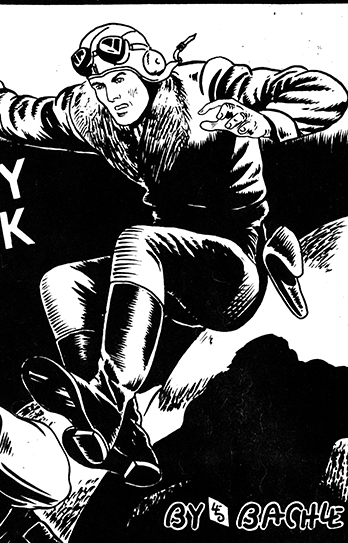
In celebration of the Johnny Canuck Kickstarter Campaign to reprint! Support before it’s too late!
Throughout 1941, Canadian comic book readers experienced a boom in Canadian produced comics. It wasn’t until late in that year that Johnny Canuck was slated to appear.
In December of 1940, American luxury goods (including comics) were forced out of the Canadian market. Without the heroes that Canadian children had come to know and love like Batman and Superman, Canadian publishers got a clear shot to produce Canadian ones. Foremost of these heroes was none other than Canada’s answer to Captain America, Johnny Canuck.
 Johnny originally appeared in the first issue of Dime comics, which likely appeared on news stands in late December 1941 or January 1942, but whose publication date is February. Johnny’s creator, Leo Bachle, was just 16 at the time he created the comic for Cy Bell and John Ezrin. Despite Bachle’s youth, Johnny Canuck would go on to be one of Bell Feature’s biggest characters, and indeed, one of the biggest and most lasting characters of the Golden Age. The comic itself is just over 230 pages of comics spread across 28 issues and 7 arcs. The first and last issue are the only issues to be one shots.
Johnny originally appeared in the first issue of Dime comics, which likely appeared on news stands in late December 1941 or January 1942, but whose publication date is February. Johnny’s creator, Leo Bachle, was just 16 at the time he created the comic for Cy Bell and John Ezrin. Despite Bachle’s youth, Johnny Canuck would go on to be one of Bell Feature’s biggest characters, and indeed, one of the biggest and most lasting characters of the Golden Age. The comic itself is just over 230 pages of comics spread across 28 issues and 7 arcs. The first and last issue are the only issues to be one shots.
Although Leo Bachle created the character and worked on the comic for most of the series, he left Johnny Canuck and Bell Features to take a position in New York. Subsequently, Johnny was handled by Andre Kulbach from issue 24 to 27, and Paul Dak took the last issue.
 Johnny’s character was kind of a Jack of all trades, a flying ace and fighter, secret agent, and officer in the Canadian military. Most of the time, Johnny was saving “foreign beauties” and fought the axis on almost every war front. He met up with Hitler no fewer than three times and was trained in trapeze and boxing! Throughout his comics he travelled to Yugoslavia, Russia, Germany, Libya, Tibet, and China. It wasn’t until the final issue that Johnny’s story took place in Canada, and just off the coast of Halifax! Interestingly, this story also had a science fiction feel, as this last comic took place after the end of the war, and essentially, after Johnny’s biggest villain was out of the picture!
Johnny’s character was kind of a Jack of all trades, a flying ace and fighter, secret agent, and officer in the Canadian military. Most of the time, Johnny was saving “foreign beauties” and fought the axis on almost every war front. He met up with Hitler no fewer than three times and was trained in trapeze and boxing! Throughout his comics he travelled to Yugoslavia, Russia, Germany, Libya, Tibet, and China. It wasn’t until the final issue that Johnny’s story took place in Canada, and just off the coast of Halifax! Interestingly, this story also had a science fiction feel, as this last comic took place after the end of the war, and essentially, after Johnny’s biggest villain was out of the picture!
Recently, like Nelvana of the Northern Lights, I’ve been privileged with the position of collecting, restoring, and publishing Johnny Canuck! It’s never been reprinted in the seventy years since the last issue hit the rack! But I need your help! I’m raising the funds through kickstarter, a crowd funding website! Preorder the book here and get all kinds of other cool stuff like prints, posters and even original art by some of todays top creators! Let’s read Johnny’s adventures again!




